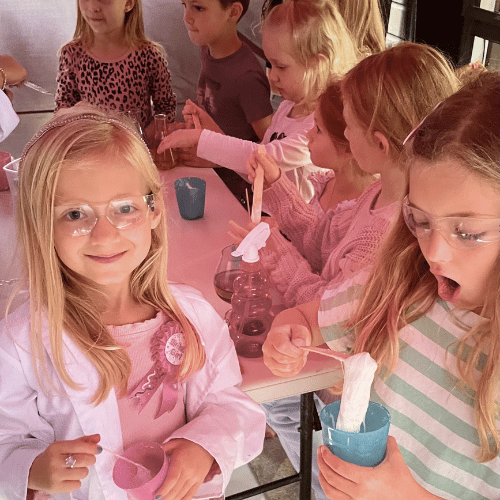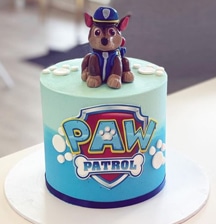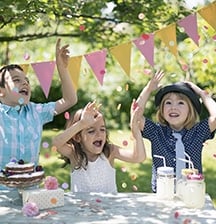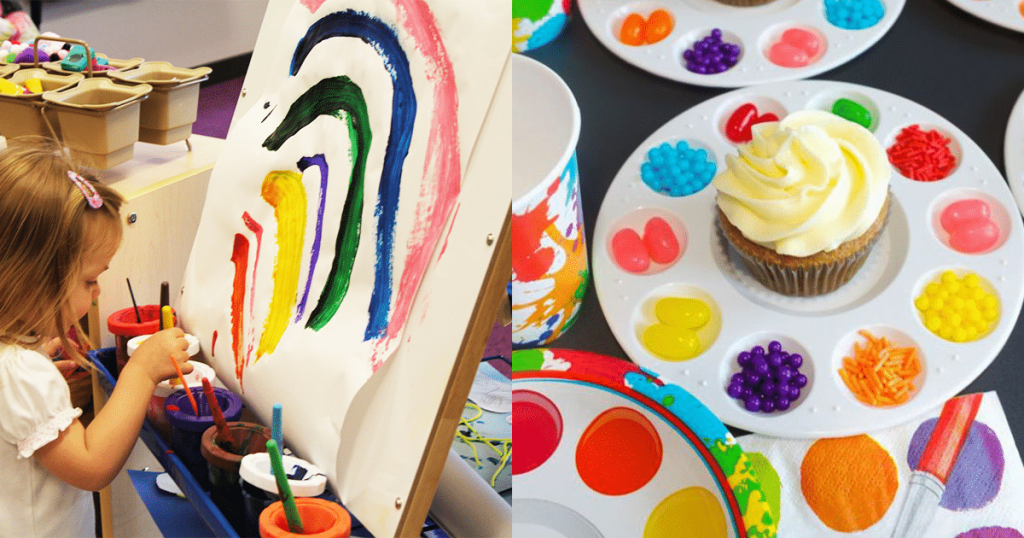
Planning a child’s birthday party this year? Maraya Robinson shares her low-stress guide to organising the ultimate birthday party (while keeping your sanity intact).
1. Set a realistic budget
A memorable party doesn’t have to break the bank. Decide on a reasonable budget that suits your financial comfort level, and stick to it. Try our printable party budget worksheet to help you stay on track.
Party budgeting doesn’t need to be a hassle! Download our handy party budget printable below:
2. Choose the location
The venue for your child’s birthday party can either add to or detract from your stress levels. Some people prefer to stick close to home, while others would rather contract out the responsibility (and the clean-up!).
Home
Advantages:
- Familiar environment for the birthday child.
- Complete control over decorations and setup.
- Cost-effective compared to renting a venue.
Considerations:
- Limited space may restrict the number of guests.
- Cleaning up afterward may be more extensive.
- Noise constraints in residential areas.
Park
Advantages:
- Outdoor setting provides a natural and spacious environment.
- Often equipped with playgrounds for additional entertainment.
- No need to worry about cleaning up your home.
Considerations:
- Weather-dependent; consider a backup plan for rain.
- May require permits for larger gatherings.
- Limited access to facilities like bathrooms and electricity.
Beach
Advantages:
- Scenic and picturesque setting.
- Plenty of space for games and activities.
- Offers a variety of natural entertainment (sandcastles, beach games).
Considerations:
- Weather-dependent; consider a backup plan.
- May require permits for large groups.
- Limited facilities; plan for portable restrooms.
Entertainment venue
Advantages:
- Professional atmosphere with dedicated staff.
- Often includes built-in entertainment options.
- No need for extensive setup and cleanup.
Considerations:
- Generally more expensive than other options.
- Limited customisation compared to a home or park.
- Availability may be limited; book well in advance.
3. Pick a time
When (and for how long) you hold your child’s birthday party is just as important as where. Remember, little people get tired (doubly so when they are super-excited and active), so time your party just right.
Toddlers (1-3 years old)
Best time: Late morning or early afternoon.
Why: Toddlers tend to be most energetic and engaged earlier in the day. After a good nap and meal, they’re ready to play. Keep the party short and sweet, lasting about 1-2 hours.
Preschoolers (3-4 years old)
Best time: Mid-morning or early afternoon.
Why: Preschool-aged kids are usually full of energy after a good night’s sleep. Mid-morning or early afternoon ensures they are well-rested, and you can plan fun activities without interfering with nap times.
Primary school age (5-8 years old)
Best time: Afternoon.
Why: After-school hours work well for this age group. You can plan a slightly longer party, but keep in mind homework and bedtime routines, aiming to conclude the event by early evening.
Intermediate school age (9-12 years old):
Best time: Late afternoon or early evening.
Why: Older kids might enjoy an after-school party or one that starts later in the day. You can plan more structured activities, games, and even an early dinner if the party extends into the evening.
Teens (13+ years old):
Best time: Early evening or night.
Why: Teens often prefer evening parties. You can consider a dinner party, a movie night, or even an evening at an entertainment venue. Be mindful of curfews and transportation arrangements.
4. Sort the invitations
The world of birthday party invitations is a fraught one. If your venue is small or you just want to have a little party, there’s always a chance that a child who isn’t invited might feel left out. Equally, if you invite to many kids, things can devolve into mayhem. Decide early on what’s the right number for your party location – remember that for smaller children, parents are likely to want to stay for the party too.
If you’re inviting school friends, have a quiet word to the teacher and ask if she can discreetly give the invitations to the guests, or quietly slip them to the other parents at school drop-off or pick-up. Have a chat to your child about not bragging that they’ve invited so-and-so but not so-and-so – excited birthday children don’t mean any harm, but feelings can inadvertently be hurt.
Standard paper invitations are still the norm for younger kids’ parties – you can get personalised ones online, design your own if you’re creative, or buy premade ones and fill in the details.
Older kids can handle their own invites and send texts or messages to their friends – just be sure to monitor who they’re inviting so you don’t end up with a house full of unexpected extras.
It’s a good idea to send out invites three weeks to a month in advance, and ask for RSVPs – but be aware that many people forget to RSVP by the deadline, so you might need to follow up.
Consider the personality of the birthday child when making your guest list. A more shy or reserved child might not enjoy their own party if they’re surrounded by gregarious friends. A more outgoing child will appreciate other kids who are happy to get stuck into playing party games and aren’t timidly hanging back.
5. Figure out the food
Party food can be divided into three categories – kids’ food, adults’ food, and cake. What to feed the kids depends on what time of day you’re holding the party – morning tea, lunch, etc – but honestly, kids are happy with simple party staples like cheerios, fairy bread, sausage rolls, chicken nuggets, and snack food like chips and pretzels. You can go all out and theme the food around the party theme – we’ve seen a pretty spectacular Very Hungry Caterpillar shindig with all the food from the book on offer – but truly, simple is best. Adults also love party food (and an excuse to eat it – why don’t adult parties have fairy bread?) or you can do something easy like order pizzas for everyone to munch on. This is a low-stress guide, and sticking with simple, classic food options you don’t have to do much to prepare will definitely save you some angst.
When it comes to birthday cake, you can make it yourself – arguably cheaper, but possibly more stressful – or get a cake made. Local supermarkets often have very good, simple cakes that aren’t too expensive, or you can splurge on something a bit fancier from a cake maker or bakery. Another idea is to have cupcakes – then there’s no messy cake cutting to deal with.
Food allergies are on the rise, so when your guests RSVP, ask whether there are any dietary needs – it’ll save you being caught out on the day if you can plan ahead for a nut-free party or gluten-free options, for example.
Loot bags: Yes or no?
Expectations for goodie bags (and their contents) can vary based on age, cultural differences, party themes, and regional traditions. If you do give out loot bags, keep them simple – a balloon, sticker, and small chocolate bar are perfect. If you’re not planning to give out loot bags, that’s fine too. You might want to tell parents ahead of time (when they RSVP): “Just so you know, we decided not to do loot bags. We’re focusing on having a good time at the party instead. I hope that’s okay.” This way parents can prep their kids ahead of time not to be asking where their loot bag in before they depart. Consider the quality of the overall party experience to be your primary focus – not the take-home (and it’ll save you some money).
Fill your own: party goers can fill their own loot bag with cake and prizes from the games.
What do I do if…
It’s helpful to have some contingency plans if things go awry. Here are some party problem-solvers.
Low attendance:
- Plan flexible activities that can be adjusted based on the number of attendees.
- Personalise the experience for a more intimate celebration.
- Incorporate spontaneous surprises and adjust catering plans accordingly.
Surprise guests:
- Ensure flexibility in catering plans – you can always order an extra pizza or two.
- Adjust activities to accommodate additional participants.
- Communicate with parents of surprise guests to address any specific needs.
Here’s a great way to work with your child to plan their party while keeping the conversation focussed!
50 party theme ideas
- Superhero Extravaganza
- Princess Paradise
- Dinosaur Adventure
- Space Odyssey
- Under The Sea
- Safari Expedition
- Candyland Carnival
- Alice In Wonderland Tea Party
- Lego Land
- Mad Scientist Lab
- Rainbow Unicorn Fantasy
- Sports Mania
- Jungle Safari
- Mermaid Lagoon
- Monster Mash
- Hawaiian Luau
- Circus Spectacular
- Wizardry And Magic
- Construction Crew
- Fairy Tale Kingdom
- Super Mario Bros
- Emoji Extravaganza
- Ice Cream Pool Party
- Detective Mystery Party
- Movie Magic
- Pokemon Adventure
- Artistic Masterpieces
- Disco Fever
- Camping Adventure
- Pirate Treasure Hunt
- Minecraft Madness
- Bug Safari
- Pyjama Jam
- Rock Climbing Adventure
- Peppa Pig Picnic
- Science Lab
- Wacky Water Park
- Angry Birds Invasion
- Disney Fantasy
- Minions Mayhem
- Carnival Celebration
- Paw Patrol Pup Party
- Toy Story Adventure
- Zookeeper Experience
- Royal Tea Party
- Antarctic Adventure
- Balloon Bash
- Bookworm Banquet
- Ninja Squad
- Pokemon Party








